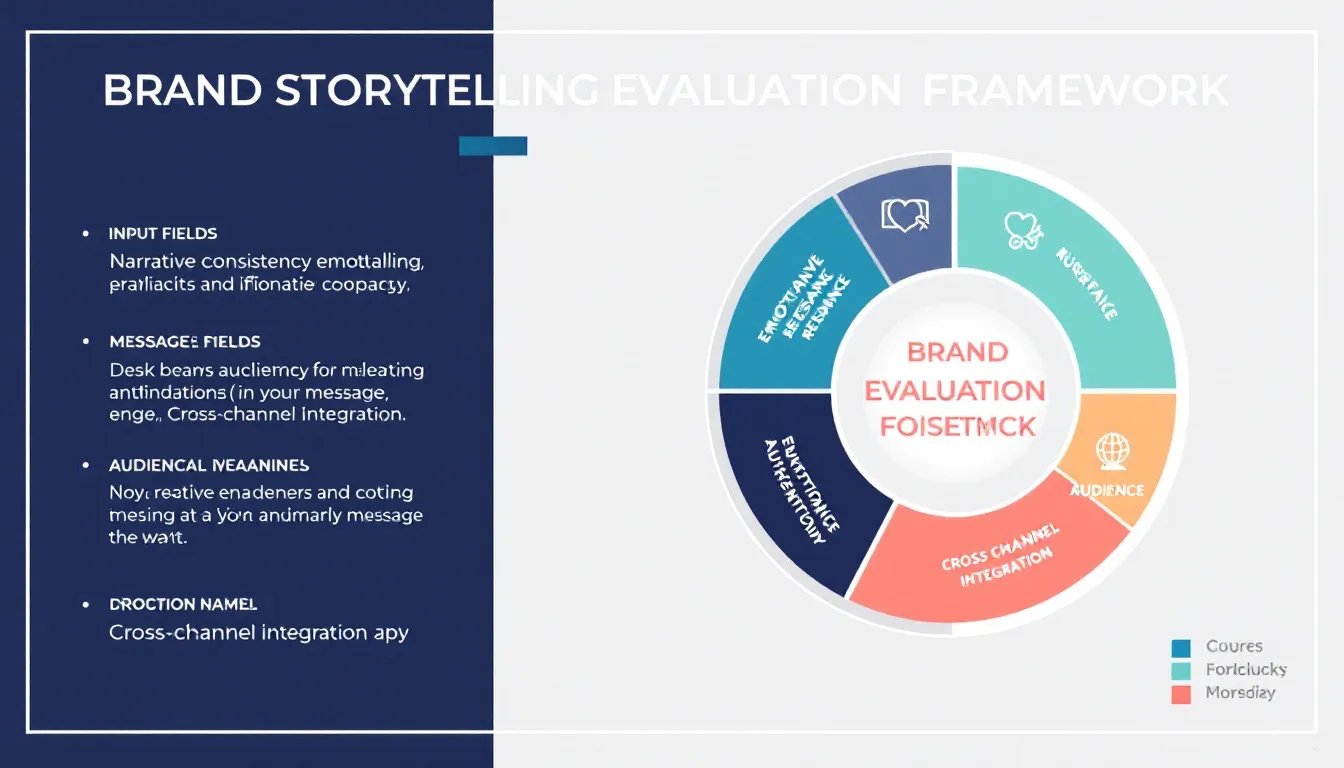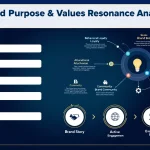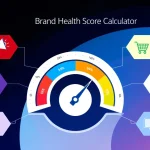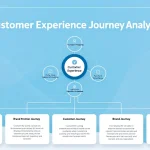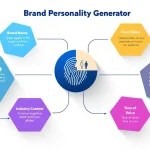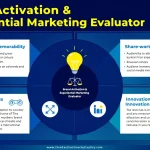Is this tool helpful?
How to Use the Brand Storytelling Evaluation Tool Effectively
To get the most accurate and actionable insights from the Brand Storytelling Evaluation Tool, follow these steps when filling out the evaluation form:
- Brand Name: Enter the name of the brand you want to assess. Example inputs: “Blue Ridge Outdoors” or “Fresh Bites Cafe”.
- Target Audience: Clearly describe the primary audience your brand aims to reach. Example inputs: “Health-conscious parents aged 30-45” or “Young urban professionals interested in tech gadgets”.
- Brand Purpose: Share your company’s mission statement or core brand values. Example inputs: “To empower communities through sustainable energy solutions” or “To offer delicious, affordable organic meals for busy people”.
- Brand Touchpoints: List the channels where your customers interact with your brand. This is optional but helps provide a broader perspective. Example inputs: Mobile app, YouTube, In-store displays or Facebook, Email marketing, Customer support chat.
- Current Brand Stories: Describe recent campaigns, social media posts, or messaging themes your brand uses. This is optional but enriches the analysis. Example inputs: “User testimonials on product benefits” or “Community clean-up event highlights”.
What Is the Brand Storytelling Evaluation Tool and Why Use It?
The Brand Storytelling Evaluation Tool helps you measure how well your brand communicates its core message, values, and mission across various platforms. It assesses the authenticity and emotional appeal of your story while identifying areas that need improvement.
By analyzing key elements like narrative consistency and audience engagement, the tool delivers clear feedback and practical recommendations. This streamlines your brand storytelling strategy, making your message more memorable, relatable, and authentic across all customer interactions.
Key Benefits You Gain from Using This Tool
- Insightful Analysis: Understand how coherent and emotionally engaging your story is across multiple touchpoints.
- Improved Brand Performance: Pinpoint gaps in your messaging and optimize story delivery for better audience connection.
- Stronger Market Differentiation: Clarify your unique value and position your brand distinctly against competitors.
Practical Uses of the Brand Storytelling Evaluation Tool
This tool fits a wide range of brand communication needs. Some common use cases include:
1. Brand Strategy Refinement
Before launching new campaigns, evaluate your brand’s storytelling to ensure clear and consistent messaging that resonates with your target audience.
2. Rebranding and Positioning
When refreshing your brand identity, the tool helps assess messaging impact, emotional appeal, and audience alignment across various channels.
3. Multi-Channel Campaign Optimization
Analyze how well your story integrates across digital platforms, social media, in-store experiences, and content marketing to deliver a seamless narrative.
Essential Components of Brand Storytelling Analysis
- Narrative Consistency: Checks if your messaging is uniform across channels.
- Emotional Resonance: Measures the connection your story creates with your audience.
- Message Authenticity: Evaluates how genuine and believable your brand narrative feels.
- Audience Engagement: Looks at how effectively your story motivates listener interaction.
- Cross-channel Integration: Assesses the smooth flow of your story across all customer touchpoints.
Real-World Example: Evaluating a Local Artisan Bakery
Imagine you run a bakery called “Crust & Crumbs” that focuses on organic ingredients and community values. Here’s how you might use the tool:
- Brand Name: Crust & Crumbs
- Target Audience: Food lovers aged 28-50 who prioritize organic and locally sourced products
- Brand Purpose: To bring authentic, handmade organic breads to the local community
- Touchpoints: Bakery storefront, Instagram, local farmers markets, email newsletter
- Current Stories: Behind-the-scenes bread baking videos, customer feature stories
The tool provides clear feedback on messaging consistency, emotional connection with customers, and authenticity of the brand’s story — all of which help shape stronger marketing efforts and build customer loyalty.
Industry-Specific Applications
E-commerce Brands
- Enhance storytelling across digital touchpoints like websites and social media
- Amplify customer journey narratives that build trust and social proof
- Strengthen product page stories to improve conversions
Service-Based Businesses
- Elevate client relationship stories to showcase value
- Highlight expert positioning and thought leadership through authentic content
- Communicate your service benefits clearly to attract the right clientele
Frequently Asked Questions about Brand Storytelling Evaluation
What elements make a brand story effective?
An effective brand story combines authenticity, clear alignment with your brand’s purpose, emotional resonance, and consistent delivery across all customer touchpoints.
How often should I assess my brand storytelling?
Perform evaluations quarterly to keep your messaging aligned with evolving market trends and audience preferences.
Can small businesses benefit from this tool?
Absolutely. This tool suits businesses of all sizes, helping you sharpen your brand’s story and customer connection regardless of scale.
What should I include in my brand story?
Your brand story should cover your company’s mission, values, customer benefits, and emotional connections to help you stand out.
How do I deepen emotional connections with my audience?
Share authentic customer experiences, relatable challenges, and meaningful solutions. Keep your messaging consistent and genuine across all platforms.
Best Practices for Applying Your Brand Storytelling Evaluation Results
1. Plan Strategic Implementation
- Focus on high-priority recommendations first
- Set clear timelines for each step
- Assign accountability to specific team members
2. Monitor Progress Regularly
- Track key performance indicators related to storytelling
- Collect feedback from your audience
- Measure engagement with campaigns and content
3. Embrace Continuous Improvement
- Keep repeating evaluation cycles to stay aligned with your audience and market
- Incorporate audience insights to refine messaging
- Adapt to emerging trends and new communication channels
Advanced Brand Storytelling Techniques to Explore
1. Transmedia Storytelling
- Develop narratives that span multiple platforms seamlessly
- Create channel-specific content adaptations while maintaining unified messaging
- Coordinate your story across social media, email, in-store, and more
2. User-Generated Content Integration
- Incorporate real customer stories and testimonials
- Foster a community around shared brand experiences
- Build authentic social proof that enhances trust
3. Data-Driven Storytelling
- Use audience insights to tailor your narratives
- Analyze performance metrics to refine your approach
- Optimize content continuously for maximum impact
Important Disclaimer
The calculations, results, and content provided by our tools are not guaranteed to be accurate, complete, or reliable. Users are responsible for verifying and interpreting the results. Our content and tools may contain errors, biases, or inconsistencies. Do not enter personal data, sensitive information, or personally identifiable information in our web forms or tools. Such data entry violates our terms of service and may result in unauthorized disclosure to third parties. We reserve the right to save inputs and outputs from our tools for the purposes of error debugging, bias identification, and performance improvement. External companies providing AI models used in our tools may also save and process data in accordance with their own policies. By using our tools, you consent to this data collection and processing. We reserve the right to limit the usage of our tools based on current usability factors.
